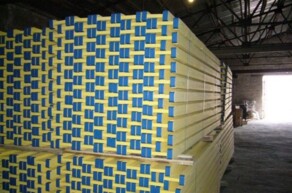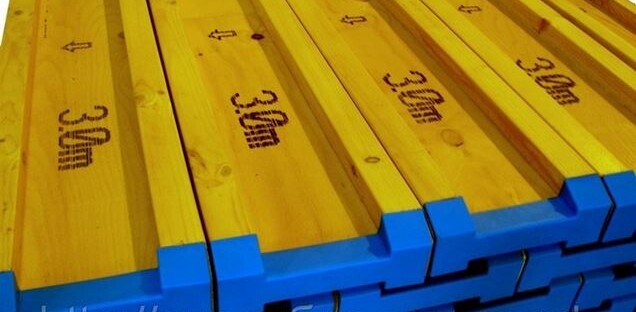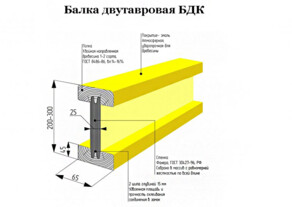Zolotaya st., 11, BC "Gold", of. 10A20
moscow@refw.ru
Tel.: 8 495 249 03 04
Tel.: 8 800 5 504 504
Bolshoy Sampsonievsky pr., 4-6, lit. A, BC "Montblan", room 3n, office 311
st.petersburg@refw.ru
Tel.: 8 812 779 19 00
398010 Gryazi, Lipetsk region
lipetsk@refw.ru
Tel.: +7 4742 37 77 00
Coordinates 60.055633, 30.719067
Head of the warehouse Odarchuk Konstantin
+7 921 341-97-31
Opening hours - 9:00 - 18:00
Coordinates: 56.131419b 37.395724
Head of the warehouse Alexander Gulin
+7 906 710-46-09
Opening hours - 8:30 - 17:30

Beam for (assemblying floor formwork for) monolithic construction is distinguished by high quality, reasonable price, excellent operational characteristics.
Beam is a glued laminated timber flanged formwork beam. Serves as a supporting element in the construction of horizontal and inclined formwork for creation of monolithic concrete and reinforced concrete structures. It can be used instead of load-bearing beams for interstorey floors.
Structurally, the product consists of two flanges made of spruce or pine timber with a cross-section of 80x40 mm, and an intermediate web made of moisture-resistant FK plywood with a thickness of 24 or 27 mm. Height of a flanged beam is 200 mm.
The elements are connected with a structural polyurethane adhesive. The edge is protected with waterproof varnish or plastic plugs.
|
Parameter |
Value (a) |
Deviation (b) |
||
|
Beam height |
200 mm |
± 2 mm |
||
|
Beam flange height |
40 mm |
± 0.6 mm |
||
|
Beam flange width |
80 mm |
+ 0.8 mm/ -1.2 mm |
||
|
Beam web thickness |
24 mm |
± 1 mm |
||
|
Beam length |
up to 3 m |
± 3.0 |
||
|
Beam lengthover |
over 3 m |
± 5.0 |
Beam flange
Our production uses oriented timber of traditional coniferous species. It provides the structure with strength.
Beam web
For web production, birch plywood FSF with thickness of 24 mm (27 mm) is used. The base is built up lengthwise using a tenon joint.
Coating
Finished product surface is treated with antiseptic waterproof paint. Plastic tips are installed on the beam edges.
Glueing
For internal strengthening of the beam structure, polyurethane waterproof glue "KLEIBERIT 508.5" (manufactured in Germany) is used.
SIZES
We produce beams from 1.45 to 6 m long with a 5 cm step.
Capacity is 300 000 rm per month.
Raw material humidity is one of the key factors affecting performance characteristics of the beam.
13% +/- 3% is the optimal raw material humidity. Since too humid wood (18-22%) dries out over time and this causes buckling and cracks, these effects influence the geometry and load-bearing capacity.
Growth rings are oriented from the web outward. This arrangement of the flange (beam) ensures absence of cracks and chips when hammering nails during installation.
Automatic splicing line allows to relieve stress in the wood. Splicing of the beam is carried out using the mini-tenon technology. Due to this, the ideal beam geometry with enhanced strength characteristics is obtained.
Beam flange is spliced using mini-tenon technology and fixed with a polyurethane glue, which significantly increases its strength characteristics.
Beam web is made of 24 mm thick water-resistant birch plywood. Birch plywood FSF, with its high strength and wear resistance, is ideal for the harsh Russian climate.
Flanges and webs are connected with a double 13mm high tapered tenon and glued with a two-component polyurethane glue.
Water-resistant impregnation with antiseptic properties ensures absence of fungus and mold. Such beam can be stored outside, under a shelter.
The edges are safely protected by a plastic tip, which prevents the beam from splitting when dropped from a height and protects the ends from moisture. The tip also gives a construction worker the impression that the beam is part of a finished, integral piece of equipment, protecting the beam from being cut.
Zolotaya st., 11, BC "Gold", of. 10A20
moscow@refw.ru
Tel.: 8 495 249 03 04
Tel.: 8 800 5 504 504

